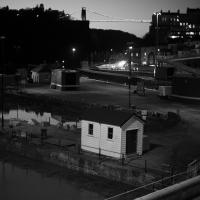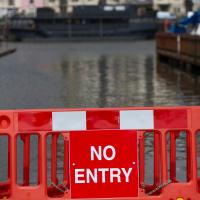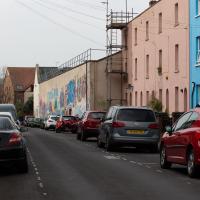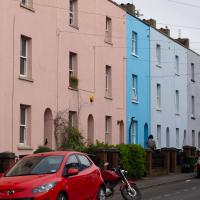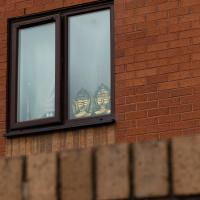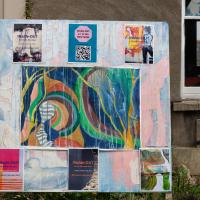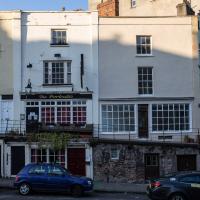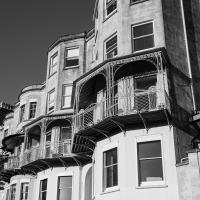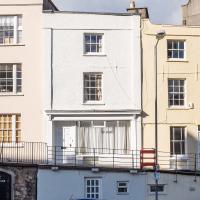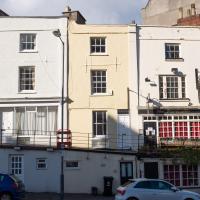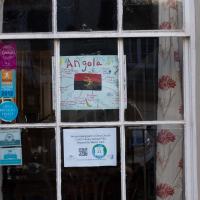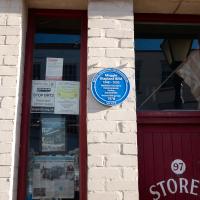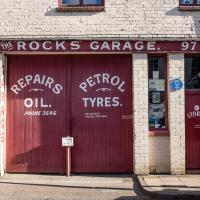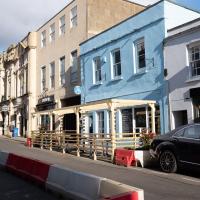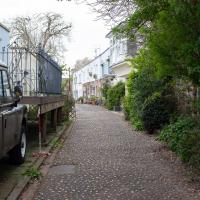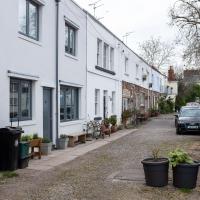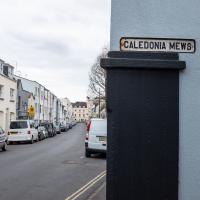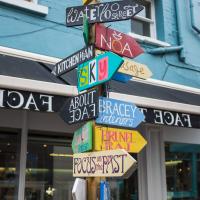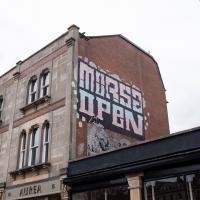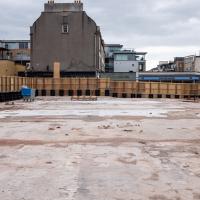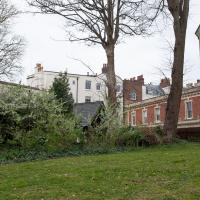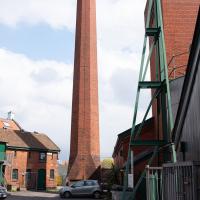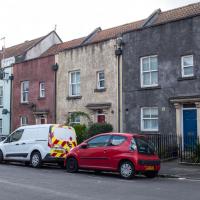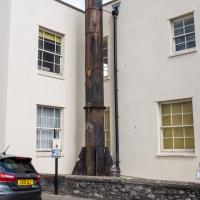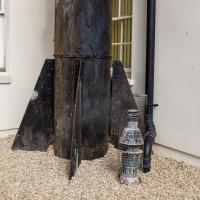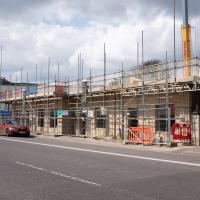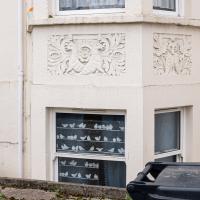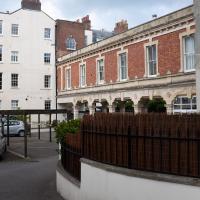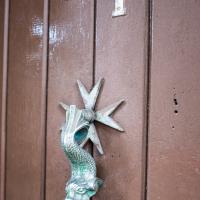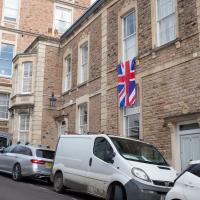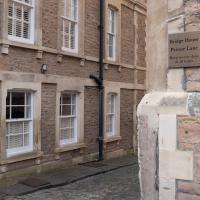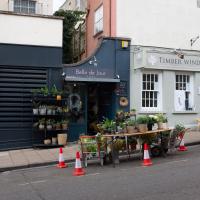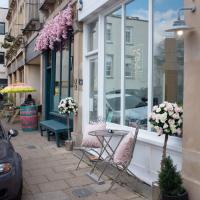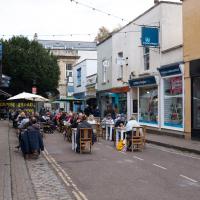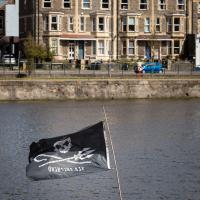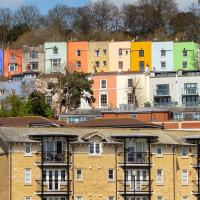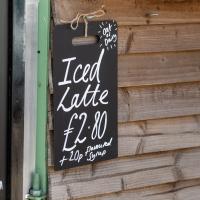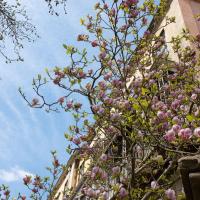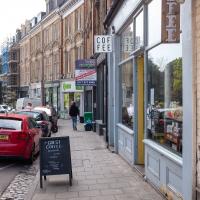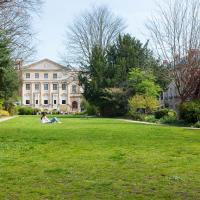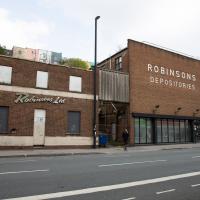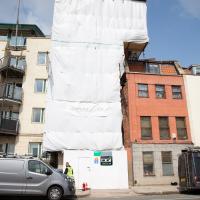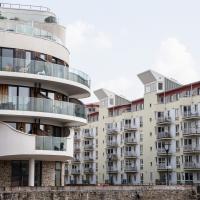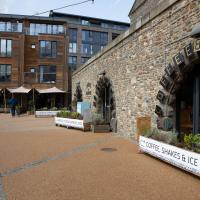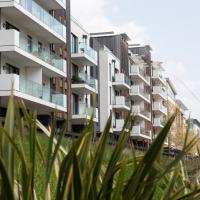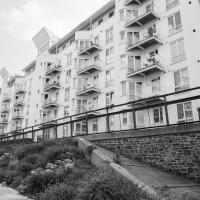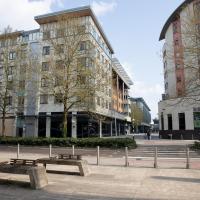Tagged: window
Hotwells Evening
29 Mar 2021
Just a little potter around Hotwells with Sarah and Vik. I didn't visit any new streets, but I liked a couple of the photos a lot.
Swinging By Sydney Row
01 Apr 2021
Another workday, another quick coffee excursion. This time I decided to swing past Sydney Row on the way back from the marina car park where Imagine That have their horsebox. I didn't know until recently that the terrace was built for workers at the adjacent dockyard.
I've also gradually come to the conclusion that I don't really think very two-dimensionally when it comes to finding my way around or associating one place with another. I only realised in the last few days that the odd industrial building that takes up the other half of Syndey Row, the one that's always covered with graffiti, is the back of the dockyard works. In my defence, as it's tucked away in a corner of the little industrial estate that I've never ventured into (I rarely find I have a need for the products of safety valve manufacturers), I don't think I've ever seen the front of the building...
That website doesn't seem to be there, which seems a bit odd for a sign that's only just gone up.
I noticed I'd missed a bit of Circular Road and Ladies Mile, and it was a nice evening for a sunset wander up to Clifton. There was something I recorded along the way, not photographically but in video.
Bristol Zoo, the world's oldest provincial zoo, has recently decided to close its Clifton site after 185 years of occupation, which means that the sounds of wild animals will no longer drift incongruously through this leafy Georgian area. They're moving everything up to their existing second site, The Wild Place Project near Cribbs Causeway. As I was wandering the Downs, I heard some fierce roaring noises, so I decided to see if I could get a little closer while they were still going on and record a sound that's soon to disappear.
I don't have a way yet to put video directly on this site, so here's a link to the video of my attempt to catch a bit of the zoo noises that I just popped on YouTube. It's sad that this might be the last time I hear such noises in Clifton.
I was trying to take a photo of the Portcullis and what I thought was also a disused pub next door, assuming it was big building on the right, but according to this discussion on Flickr, the Gaping Goose was actually next-door-but-one. I'll have to see if I can reproduce that photo of the sign...
An Evening Wander to the Gallows
06 Apr 2021
I'd originally intended just to pop up to the area around Alma Road, where I'd missed a few streets on earlier wanders. It was such a nice evening, though, I decided to extend my walk up to the very top of Pembroke Road, just outside my one mile radius, to take a few snaps of something intriguing I'd found in my researches.
I've driven, walked and jogged past the little triangle of land at the top of Pembroke road a great deal in my time in Bristol, but I didn't know that it used to be the site of a gibbet, in fact that the road itself there used to be called Gallows Acre Lane. According to the Durdham Down history trail, by Francis Greenacre (an excellent name for a Downs researcher!) among other sources:
...it was below this quarry near the top of Pembroke Road, once called Gallows Acre Lane, that a gibbet stood. It was sometimes occupied by those who had committed robberies on the Downs and was last used in 1783 to hang Shenkin Protheroe for the murder of a drover. Stories quickly spread that he descended from the gibbet at midnight every night and stalked through Clifton. Such was the alarm that his body was cut down
and buried.
Also very close to this little triangle of land was one of the gates of the extensive turnpike system...
Anyway. Along the way I encountered a wooden tortoise and a real squirrel, among other things. It was a good walk, and more light in the evenings means I can move my wanders out of the ticking countdown clock of work lunch-hours and be a bit more leisurely.
I came across this photo of 5 Wellington Terrace back when it was the Gaping Goose, two doors down from the Portcullis, and decided to snap the site as it is today. Interesting comparison!
There's a lot of outdoor trails of one kind or other going on, what with the current cicumstances.
The late, great Maggie Shapland was a familiar feature to anyone interested in historical industry in Bristol.
I think the first time I saw her was on an Open Doors Day for the Clifton Rocks railway, the disused funicular from the Avon Gorge Hotel down to near the landing stage in Hotwells, and the last time was when she was helping to restore Brunel's Other Bridge at Howard's Lock.
Both times I think she'd driven there in one or other of the classic cars she maintained. Sometimes when the garage door here was open on the way past you could sneak a look at the collection.
The last thing I saw her drive was this Moss kit car.
An amazing person by all accounts, I never knew that we shared the profession of "Database Consultant"...
A great fish restaurant, clearly gearing up for some al fresco dining once the lockdown eases up a bit.
Clifton Village Lunchtime Coffee
07 Apr 2021
Unusually for my recent lunchtime coffee trips, I managed to find a new road to walk down: Caledonia Mews, which has a little entrance off Princess Victoria Street and runs between it and Caledonia Place. I've noticed it before a couple of times—if you look up from Princess Victoria Street you can see some of it, standing tall above the low buildings on the street itself—but until last night I'd not set foot in it, I think.
As well as focusing on this charming little mews, I looked in on the demolished site of the old WH Smith, and spotted what I think is part of the now-private-houses St Vincent Rocks Hotel that I'd not really noticed before, tucked away between Sion Lane and Sion Hill.
The entrance is on Princess Victoria Street, but I imagine based on the name that it was built as a mews for Caledonia Place, which lies on the other side, forming, with West Mall, the surrounding streets of the Mall garden.
It's a lovely little mews, and looks very well-kept. I like the way that despite being fairly uniform in size and height that things are a bit more mismatched and higgledy-piggledy once you look a little closer.
I'm glad I added a search feature to the site recently, as it let me find this earlier photo when the name rang a vague bell. Morsa clearly gets about a bit.
I think the corridor you can see running from the back of the building on Sion Hill to the building on the right, on Sion Lane, is part of the old Saint Vincent Rocks Hotel. It was converted into houses, and the front bit, just the main building on Sion Hill, called Trafalgar House now, was on the market for £1,550,000 back in 2019.
The listing mentions:
To the rear a late C19 long brick extension raised on open arches
...anyway. I think it's likely the Sion Lane building was a hotel annex, though I think it's separate flats now. I wonder which of the two sides owns the corridor between them, assuming it really is a corridor? Or maybe even that's flats now...
Next time maybe I'll wander across the green bit and see what I can see over the wall. I think the area just used to be the hotel car park, but there might be more interesting things to see.
A London Wander in Southville
10 Apr 2021
There's a bit of Southville that I've been meaning to get to for some time, where the streets seem to take some strong inspiration from London. There's a Camden Road that crosses with an Islington Road, and a Dalston Road, even an Edgeware Road. For me these names are more evocative than the rather more exotic names I passed by to get there—Sydney Row or Hanover Place, say, because I've actually been to the places in London. The last time I was in Islington I saw Monkey Swallows the Universe play at The Angel, and I can't think of Camden without remembering a gondola trip with my friend Tara where a cheery youth played Beatles music for us on a saz...
I really liked this little area, with its mostly well-kept pretty houses and hints here and there of the creative side of the residents. It's arty and down-to-earth at the same time, and I wouldn't mind living there, I think.
On the way there I got the chance to walk through Underfall Yard for the first time in a while, and on the way back I had my first take-away hot food for many months, grabbing some crispy fried squid from the excellent Woky Ko at Wapping Wharf.
I was taken by the colour and texture of these three houses. I have three towels with a very similar colour and finish, at least visually...
Or, I imagine, chimney. But the fins at the bottom really do make it seem quite rockety, and when I asked about it on Twitter someone did find a strong resemblance to some NASA hardware.
As to why Charles Hill & Sons apparently needed an industrial incinerator in the basement of their office, I've not yet found out.
Like the building with the clock tower around the corner, this was apparently offices for the shipbuilding firm. The listing says it's mid-nineteenth century, and:
Originally offices for Charles Hill & Sons, formed 1848, shipbuilders at the Albion Dockyard (qv). Their last ship was launched in 1976
The former stone mason's place. Geograph has a good photo of what it looked like before. From what I can see from the planning website, it might be becoming offices, rather than the flats I'd assumed would emerge. I may have been mis-reading the vast array of planning applications, though; I suppose we'll see...
I think this may be a remnant of St Raphael's Church, whose adjacent almshouses for aged seamen are now the site of the flats at Perret's Court, just to the left there.
Ah! Yes, according to ChurchCrawler:
1853-9 by Henry Woodyer, closed 1878 following disapproval of the bishop and not reopened until 1893. Some war damage, the church was again closed and became part of a factory in 1953 and demolished 1954. Part of the W front still stands in the garden between two blocks of flats.
It was actually the decorative stone carvings of animals that caught my eye, but the birds in the window stand out a lot more in the photo.
A famous contralto, apparently. Contralto Corner quotes Sir Thomas Beecham:
"On a clear day, you could have heard her across the English Channel"
...and notes that:
She gained her DBE as a result of the WWI concerts that she organized.
There are some sturdy and pleasantly-proprotioned houses along the Coronation Road. I don't imagine they're enjoying the extra levels of traffic since Cumberland Road has been so impacted by bits of it falling into the river; it wasn't exactly quiet before. Maybe the reduction in general traffic since the pandemic has at least mitigated things.
Better Look at an Extension
14 Apr 2021
Apart from a lovely coffee and a slice of Victoria sponge from Twelve, there weren't any new sights on this little lunchtime jaunt except for a slightly better look at the long raised extension at the back of the St Vincent's Rocks Hotel, where I at least got to see the arches it's raised up on. I also got a fair bit of exercise by walking up the Zig Zag to get there, and saw far more people out than I have in months, what with the lockdown having just been significantly lifted. As I walked past The Mall pub they were turning people away from their already-full garden, and the (outdoor) cafe tables were pretty full up.
I only found out that this was a raised extension when I read the listing after snapping the last photo. Today I ventured as close as I could and got to glimpse a bit of the rather nice support arches.
I'm guessing there used to be a grand front door, but then later the hotel annexed the building and didn't need it any more? But it's only surmise.
These aren't listed per se, but they're on the "local list" and named as 8-14 St Vincents Rocks, so I think that confirms that it used to be part of the hotel.
Maybe I'm starting a knocker fixation after last weekend's walk. Interesting that it's mounted on a Maltese cross. I wonder if it was a holiday souvenir?
Surely if you want to mark the passing of the Royal Consort you'd move your dangling flag to the lower window...
Coffee, Pirates and a Spitfire
15 Apr 2021
Just a quick trip to Imagine That for a flat white and a date ball (they're really nice), snapping the general sights along the way. No new roads, as has rapidly become the default on my lunchtime wanders, but as I'm in the routine of this project it almost seems strange not to pop my wanders up on the site.
I've not had one yet this year. It's still a bit chilly for me to indulge in iced drinks.
The Mall Gardens
19 Apr 2021
Just a quick errand to the Post Office to send off Mollog's Mob, but afterwards I bought a flat white and a new plant from Foliage Cafe and headed for The Mall Gardens to enjoy sitting in the sun and reading a book on the first day this year that's been properly warm enough for it. Nice.
The Mall Gardens does actually have some signs up letting people know it's a public garden, but I think it was only my researches for this project that brought the number of public gardens there are in Clifton to my attention, and reminded me that I could make use of this space in Clifton Village, a little closer to the coffee shops and a little more sheltered than Clifton Down.
Hard to capture how nice this big magnolia in the Cornwallis Crescent back garden is on camera.
With the neoclassical frontage of The Clifton Club (originally an assembly rooms) looking posh at the back.
A New Wander, a New Cafe
21 Apr 2021
Obviously, I was trying to connect to the industrial history of the Canon's Marsh area, to the old gasworks, the docks railway, the warehouses they blew up to make way for all the rather soulless modern stuff (though I do like the Lloyds building, at least.) But what I mostly got out of today's walk is a new cafe to go to for my lunchtime outings. It's perhaps a little closer than both Imagine That and Hopper Coffee; not quite as close as Foliage and Twelve up in Clifton Village, but also not at the top of a steep hill.
No, not the mediocre Costa, but only a little way away from there: Rod and Ruby's, which opened in 2018 and which I've seen in passing several times but never popped into until today. What can I say? I was foolish. Great flat white, lovely interior, astoundingly good cannoli.
Sometimes you just have to get your head out of history and enjoy a pastry.
I know very little about the history of these buildings. There's a removals firm called Robinsons with some links to Bristol, and a building in Brimingham with an old sign saying "Robinsons Furniture Depositories", so I suppose it's possible this is a long-defunct furinture repository for a removals firm. Last planning application I can find is from 1998, before I even moved to Hotwells, granting permission to demolish "two storey office building and single storey store", which very much sounds like these two buildings.
The bit on the right still has a sign up saying it's Gnodal and Bioinduction—the firms whose car park is around the back—though Gnodal is defunct and Bioinduction sadly don't have any pictures from the Bristol office on the one-page website.
I really must poke my nose in and see if there's anything more than the apparently-tiny couryard back there.
I actually quite like this one, especially the pointed fronts of the living spaces. Decent size balconies, too.
